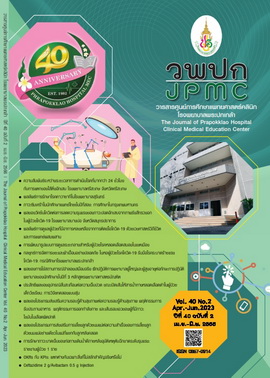Effect of Simulation-Based Learning Using for Adult and Gerontological Nursing Practicum on Nursing Skill among the Third Years Students of the Bachelor of Nursing Science Program
Main Article Content
Abstract
BACKGROUND: Patients with intubated endotracheal tubes have a chance of obstruction of sputum, resulting in a lack of oxygen to the body tissues. Therefore, providing nursing care is essential for accuracy assessment and nursing practice. Nursing students must learn and practice analytical thinking and clinical decision-making in both simulation-based learning and real situations to develop nursing skills, resulting in patient safety and receiving quality nursing care.
OBJECTIVES: This study aimed to compare the effects of simulation-based learning on third-year students' adult and gerontological nursing practice skills in the Bachelor of Nursing Science Program.
METHODS: In this quasi-experimental research study, the one-group pretest-posttest design examined subjects comprising 30 students in the Bachelor of Nursing Science Program, the third-year students, Academic Year 2022, Nakhon Pathom Rajabhat University, during November-December 2022. The research tools included simulation-based learning for adult and gerontological nursing practicum: nursing care of an intubated patient with sputum obstructive developed by the researcher. The content validity index was 0.98. The second research tool was the evaluation form of nursing practice. The content consistency index was verified to be 1.0 and the results were experimentally pooled with Simulation-based learning until the user concordance was 1.0. The statistics used for data analysis were percentage, mean, standard deviation, and paired t-test.
RESULTS: The results showed that the simulated patient condition assessment skills after using the simulation-based learning for adult and gerontological nursing practicum were significantly higher than before using simulation-based learning (t=-7.26, p<0.001), and the nursing skill after using the simulation-based learning for adult and gerontological nursing practicum were significantly higher than before using simulation-based learning (t=-3.92, p<0.001).
CONCLUSIONS: Using simulation-based learning for adult and gerontological nursing practicum results inpatient condition assessment skills and nursing skill accuracy.
Article Details

This work is licensed under a Creative Commons Attribution-NonCommercial-NoDerivatives 4.0 International License.
References
Government gazette. Announcement of the ministry of education on undergraduate qualification standards bachelor of nursing science, 2017 [Internet]. 2022 [cited 2022 Nov 20]. Available from: https://www.tnmc.or.th/images/userfiles/files/Edit(1).pdf
Weerawatthanodom N, Sirisakulpaisal B, Chairat T, Bangthamai P. Evaluation of nursing practice by the objective structured clinical examination (OSCE).Journal of Health and Nursing Research 2020;36(1):238-45.
Harnyoot O. Nursing process and implications. Journal of The Royal Thai Army Nurses 2014; 15(3):137-43
Sukcharoen P.The development of cognitive of nursing students by simulation-based learning. Journal of Graduate Volunteer Centre 2016;13(1):63-76.
Seo YH, Eom MR. The effect of simulation nursing education using the outcome-present state-test model on clinical reasoning, the problem-solving process, self-efficacy, and clinical competency in Korean nursing students. Healthcare (Basel). 2021;9:243.
Saisit W. Simulation-Based Learning: SBL for nursing practicum skill. Nakorn Pathom: Silpakorn University Printing; 2022.
Boonmee L, Pitaksin D, Choomee P, Tiyawisutsri C. Development of professional nurses' competence into nursing case managers using the framework of advanced nursing practitioners and adult learning theory. J Prapokklao Hosp Clin Med Educat Center 2018;35: 93-102.
Samerchua, Nawinprasert K, MethaN, SoravisutN. Teaching and learning in nursing by high-fidelity patient simulation. Journal of Nurses Association of Thailand Northern Office. 2020;26:1-12.
Songnapawuttikul R. Academic article using scoring rubrics as a tool for assessment in student learning. Graduate School Journal 2017; 12(1):1-14.
Knowles MS. The modern practice of adult education: from pedagogy to andragogy. New York: The Adult Education Company;1980.
Bucher L, Seckel MA. Nursing management: critical care. In: LewisS L, Dirksen SR, Heitkemper MM, Bucher L, Harding MM, editors. Medical-surgical nursing: assessment and management of clinical problems. 9th ed. St. Louis: MosbyElsevier; 2014. p.1598-630.
Natetipawan P. Thorax and lungs. In: Natetipawan P, Bhoosahas P, Panurat S, Thutsaringkarnsakul S, KrachangphoP, Thuratham W, editors. Health assessment for nurses: physical examination. 6th ed. Bangkok: Pimdee karnpim company limited.; 2021.p.79-100.
Lertlum L, Tanasansutee C, Panawatthanapisuit S, BumrungsriC. Developmentofa simulation- based learning model. The Southern College Network Journal of Nursing and Public Health 2022;6(Special Issue):43-58.
Groom JA, Henderson D, Sittner BJ. NLN/Jeffries simulation framework state of the science project: simulation design characteristics. Clinical Simulation in Nursing 2014;10:337-44.
Sinthuchai S, Ubolwan K. Fidelity simulation based learning: implementation to learning and teaching management. Journal of The Royal Thai Army Nurses 2017;18(1):29-38.

